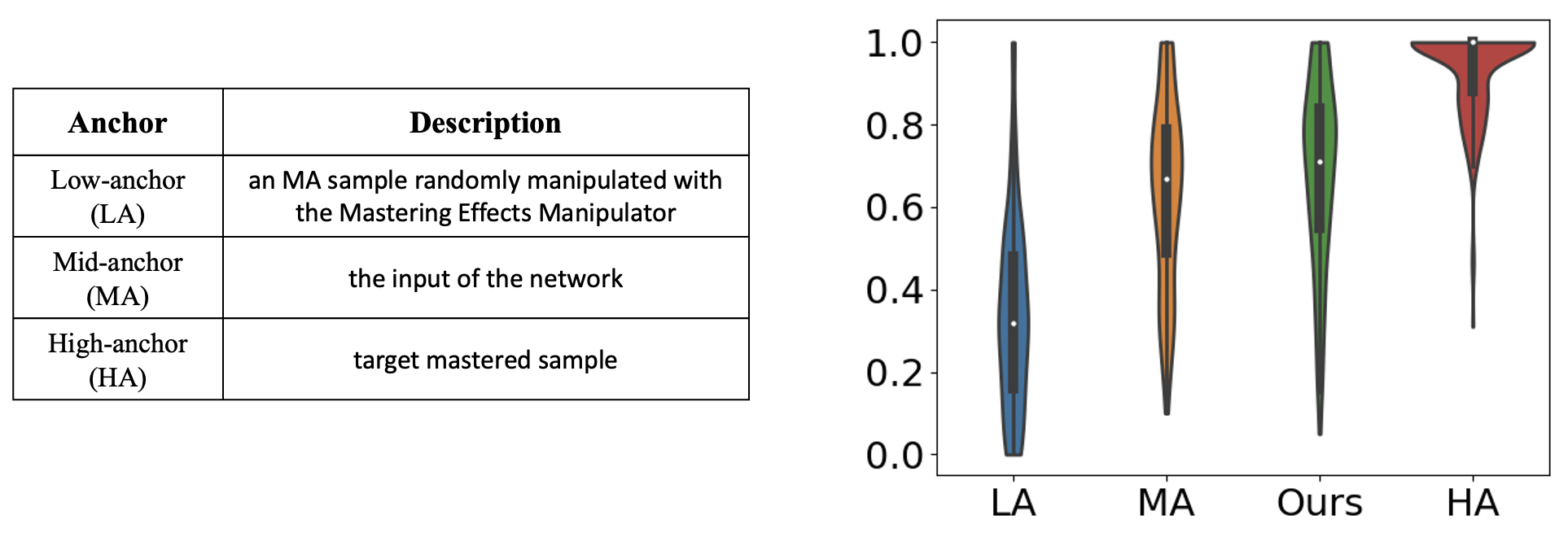Audio Samples
Results of Music Remastering from the proposed model.
The samples in this section were generated using our test dataset and were also used for the listening test.
The samples in this section were generated using our test dataset and were also used for the listening test.
Please use devices such as speakers, headphones, and earphones in a quiet environment to analyze the sound source.
| Sample Index | Reference Track | Network Input | Network Output | Random Manipulation | Ground Truth | ||
|---|---|---|---|---|---|---|---|
| #1 | + | → | |||||
| #2 | + | → | |||||
| #3 | + | → | |||||
| #4 | + | → | |||||
| #5 | + | → | |||||
| #6 | + | → | |||||
| #7 | + | → | |||||
| #8 | + | → |
Music Remastering application. The source track is remastered with the reference's mastering style.
| Original Record (Network Input) |
Reference Track | Remastered Track (Network Output) |
|---|---|---|
PROPOSED METHOD

The Mastering Cloner aims to convert the mastering effects of the input track A1 to that of the reference track B2 by conditioning the encoded feature of the reference track 2' extracted from the pre-trained Music Effects Encoder. For this procedure, tracks A and B applied with the same mastering manipulation are used as a ground truth A2 and reference track B2, where A1 is another manipulated sample and used as the input of the Mastering Cloner. The discriminator is applied with the expectation of generating realistic sounds and similar mastering effects to the projected track.
EVALUATION
The metrics of quantitative evaluation include RMS difference of stereo channels, RMS difference of side channels (RMS-side), frequency-weighted segmental Source-to-Noise Ratio (fw-SNR), and short-time objective intelligibility (STOI) to measure the performance of the volume, stereo width, tone and timbre, and perceptuality, rescpectively. We evaluate the difference between the target mastered track with our model outputs.

The listening test was conducted with 17 participants who are familiar with the concept of mastering. The participants were given a total of 15 questions and were instructed to rate each samples according to similarity of the mastering style to the reference sample on a scale from 0 to 1.
We found a significant difference with p < 0.001, with conducted multiple post-hoc paired t-tests with Bonferroni correction for each anchor with our generated samples.

SUPPLEMENTARY MATERIALS
Quantitative Results According to Reference Track's Duration
The Music Effects Encoder is capable of encoding variable-length inputs.
The results below are the quantitative results of the Mastering Cloner using different fixed duration (in seconds) of the reference track.

Mastering Effects Manipulator
The Mastering Effects Manipulator mimics the procedure of the Mastering Chain.
The input track is manipulated in the order of Pre-gain → Equalizer → Stereo Imager → Maximizer and transformed into a different mastering style. (For Pre-gain, we fix the gain value to -8.0 dB.)
| Original | Manipulated #1 | Manipulated #2 |
|---|---|---|
The details of the parameters with their random value range are shown below.
| Equalizer (5-band) | Stereo Imager (4-band) | Maximizer (Compressor) | ||||||||||||||
|---|---|---|---|---|---|---|---|---|---|---|---|---|---|---|---|---|
| Parameter | Min. | Max. | Units | Type | Parameter | Min. | Max. | Units | Type | Parameter | Min. | Max. | Units | Type | ||
| low_shelf_gain | -15 | 10 | dB | int | freq_1 | 20 | 1500 | Hz | int | threshold | -10 | -6 | dB | int | ||
| low_shelf_freq | 20 | 1000 | Hz | int | freq_2 | 1500 | 7000 | Hz | int | attack_time | 0.1 | 30.0 | ms | float | ||
| first_band_gain | -15 | 10 | dB | int | freq_3 | 7000 | 20000 | Hz | int | release_time | 50 | 100 | ms | int | ||
| first_band_freq | 200 | 5000 | Hz | int | side_balance_1 | 0.0 | 3.0 | float | ratio | 5 | 10 | int | ||||
| first_band_q | 5 | 30 | int | side_balance_2 | 0.0 | 3.0 | float | makeup_gain | 4 | 12 | dB | int | ||||
| second_band_gain | -15 | 10 | dB | int | side_balance_3 | 0.0 | 3.0 | float | ||||||||
| second_band_freq | 500 | 6000 | Hz | int | bal_4 | 0.0 | 3.0 | float | ||||||||
| second_band_q | 5 | 30 | int | |||||||||||||
| third_band_gain | -15 | 10 | dB | int | ||||||||||||
| third_band_freq | 2000 | 10000 | Hz | int | ||||||||||||
| third_band_q | 5 | 30 | int | |||||||||||||
| high_shelf_gain | -15 | 10 | dB | int | ||||||||||||
| high_shelf_freq | 8000 | 20000 | Hz | int | ||||||||||||